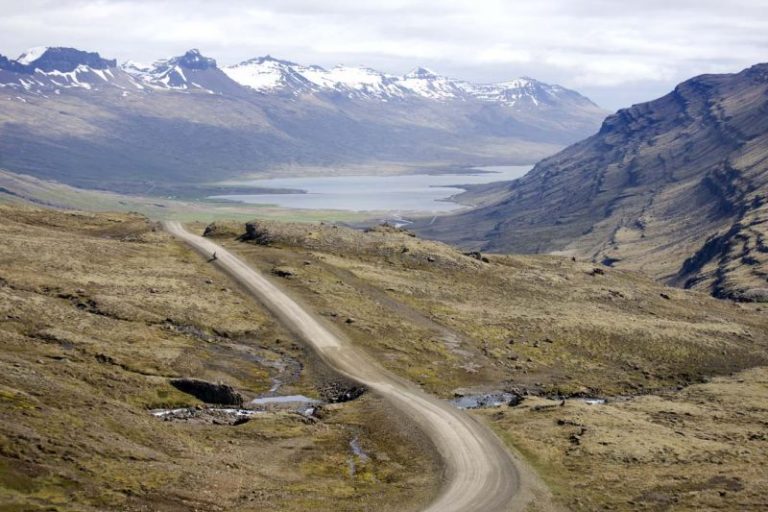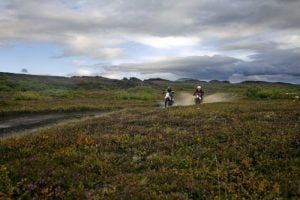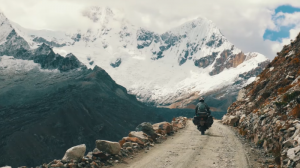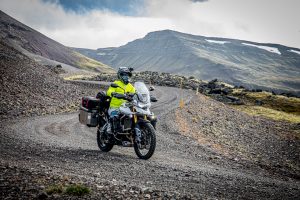Everything in Iceland is big – the jeeps, the volcanoes, and the ring road, which loops around the country for over 830 glorious miles. Lee Frost and Mark Brookes hire a couple of bikes and go for a spin.
“That’s great. Can you bring me back one of their king prawn rings and some sticky chicken skewers?” Not really the response I was soliciting when I mentioned to a neighbour that I was going to Iceland on a motorbike, but even when I’d cleared up the confusion and explained that I was referring to the country, not the local supermarket, his reaction was still unremarkable to say the least. “Why the hell do you want to go there?”
Iceland’s one of those countries that everyone’s vaguely heard of, but few know much about. It’s up in the Arctic somewhere, freezing cold, light all summer, dark all winter and inhabited by people who wear wooly jumpers, eat whale and believe in trolls. Only some of that is untrue.
It also gets a pretty bad press. In the 70s we had the Cod Wars, during which Icelandic fishermen were cutting the nets of British trawlers that illegally entered ‘their’ fishing grounds. Then Björk hit the charts and scared us half to death with her weird voice and even weirder fashion sense. In 2008 the country went bankrupt after its three main commercial banks collapsed, leaving 100 UK local authorities £840 million down and giving rise to jokes such as Q: “What’s the capital of Iceland?” A:“About £3.50”.
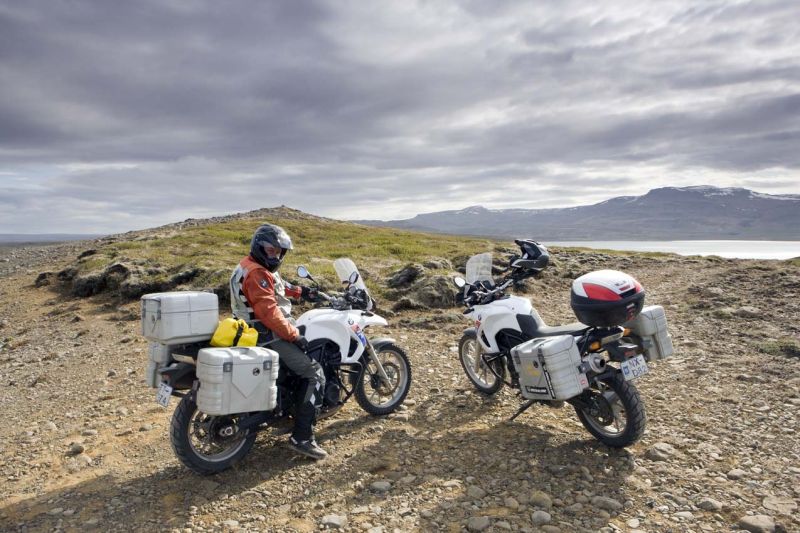
But what really put Iceland on the map in recent years occurred last April, when a violent volcanic eruption blasted through the Eyjafjallajökull glacier, kicking up an ash cloud 9km high that caused chaos across European airspace and ruined the holidays of thousands. “You wanted cash, we gave you ash” read the headlines! Oh, how we laughed. Where did yours truly happen to be? Iceland of course! Call it fate or bad planning, but when I booked the flight months earlier for my first trip to the ‘Land of fire and ice’, I had no idea what was on the horizon.
Flying into Keflavik in perfect weather, I found out. The captain announcing, ‘If you look out of the left side of the aircraft now you’ll see the Eyjafjallajökull eruption below” was surreal to say the least when airports over 1,000 miles away were closed due to ash from the very same!
As it happened, the eruption was a bonus, providing amazing photo opportunities and an unforgettable experience. But one thing became evident during that first Iceland trip – you can’t ‘do’ it in a single visit; there’s simply too much to take in. Having driven some of the roads in a hired 4×4 I also realised that it would be an awesome place for a bike trip. Think Northern Scotland on a much bigger scale with fewer people and less traffic. Mentioning this to a biking mate sealed the deal – it had to be done.
Back for more
Fast forward to June 2011 and we’re on an Icelandair flight from Glasgow to Keflavik. Our plan is to ride Route 1, better known as the ‘Ring Road’, Iceland’s one and only highway that does an impressive 832 mile loop around the island, linking all major inhabited areas. It’s paved for the most part, with some gravel stretches in the east, and was only completed in 1974. Prior to that, if you lived in the East, getting to Reykjavik involved a rather long detour via Akureyri in the north – a bit like going from Newcastle to Peterborough via Inverness. Not that you’d ever want to go to Peterborough. Many other gravel roads branch off Route 1 into the interior, but they’re generally closed to traffic until July as river crossings can be hazardous any earlier. Some roads are impassable until August if the winter has been severe, and even as late as May this year some remote communities in the North West were cut off by unexpected snowfall.
It would have been great to ride our own bikes around Iceland but with only five days to spare (work, kids, bills – you know how it is) that simply wasn’t feasible. Instead, we decided to fly out, hire a couple of BMW F650 GSs from Biking Viking (see boxout) and maximise our riding time. Within two hours of landing at Keflavik, we’d been whisked into Reykjavik by taxi, packed the bikes, changed into riding gear and got our journey underway.
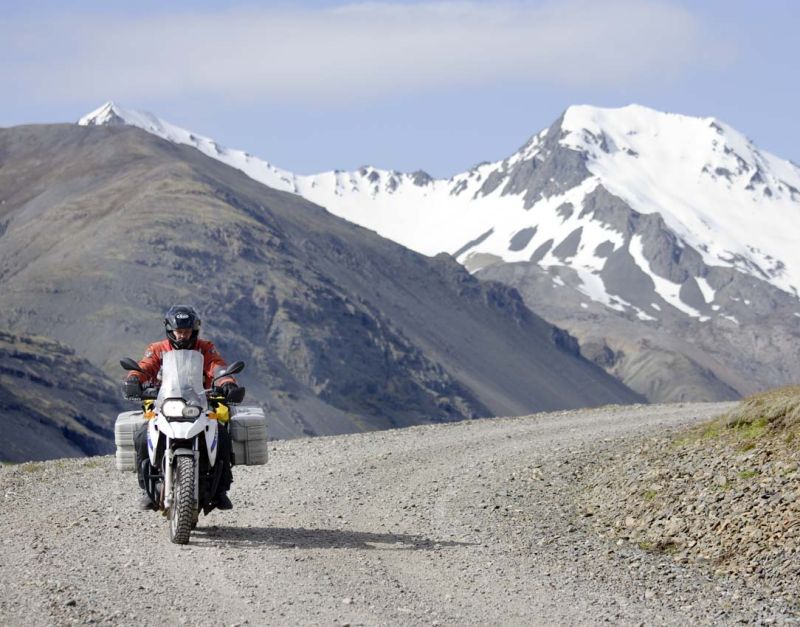
Realising it would be after 6pm before we were off on day one, I’d booked accommodation in a town called Hella (pronounced Hetla) about 100km southeast of Reykjavik – less than two hours’ ride away. With 22 hours of daylight in mid-June in Iceland we could have covered much more ground that first day, but the trip was never intended to be and Iron Butt marathon – we wanted to enjoy the ride, the roads and the scenery, and being a photographer I’d be wanting to make regular stops to capture the views.
Day two dawned bright – actually, it never really ‘dusked’- and after coffee and cake in the local bakery we headed for Höfn, 350km to the east. This is one of the best-maintained stretches of the ring road as it’s on a popular tourist route. With the busiest part of the tourist season still weeks away, however, we feel like we have it to ourselves and immediately start to enjoy the lack of traffic.
After only 30km we stop at Seljalandsfoss, a towering waterfall that plunges 60m over a rocky scarp. I decide we have to get a shot of the bikes in front of the falls so we ride them along the footpath, park up, then as I rest mine on the side stand it sinks, topples over and knocks Mark off his bike! Thankfully, there are few people around and no one spots the gaff or my blushes! Half an hour down the road we reach Skogafoss, another beautiful waterfall, then head the last 30km to Vik ĺ Mýrdal, where we stop to photograph the rock stacks of Reynisdrangar from the black volcanic sand beach and the town’s church on a hill covered with banks of wild lupins.
Time’s passing and we’ve spent too much of it off the bikes so we decide to put some distance behind us with a quick 70km burst to the next town of Klaustur, passing though a bizarre lunar landscape of low volcanic hills then green moss-covered lava fields that stretch as far as the eye can see. Less than an hour later the Vatnajökull glacier hoves into view as we reach the Skaftafell National Park and stays with us for the next 150km.
Ice ice baby
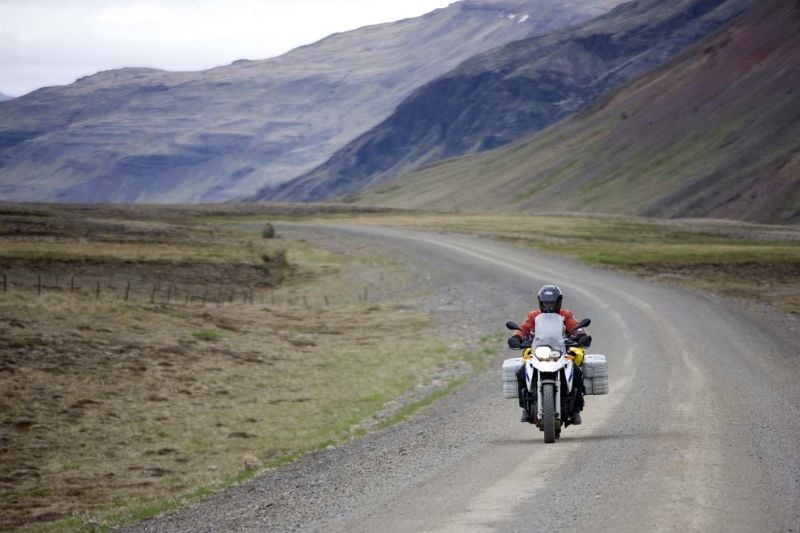
Vatnajökull is the world’s biggest icecap outside the poles and suddenly we’re riding past it. Covering 8300km – three times bigger than Luxembourg – the scale is impossible to grasp. At its fringes, glaciers pleated with deep crevasses creep between mountains like giant icy tongues. We stop at Svinafellsjökull and are awestruck by a sea of shifting, creaking ice, then the beautiful Fjallsarlön. But nothing compares to Jökulsarlón, where the Brieðamerkurjökull glacier crumbles into a deep lagoon and icebergs bob luminous-blue before floating out to sea – where the crashing waves of the North Atlantic melt and shape them into glassy ice sculptures before unceremoniously dumping them back up onto the black volcanic sand beach. It’s one of the most amazing places I’ve ever visited.
By early evening we reach Höfn (pronounced ‘Hup’), a picturesque fishing town backed by distant snow-capped mountains. Though I’m used to riding an R1150 GS, the smaller F650 GS is working out fine and other than a bit of numb bum could keep going – though we decide on a burger and a beer instead before seeing who can get to sleep first to avoid being kept awake by the other’s snoring. I win!
Men on the moon
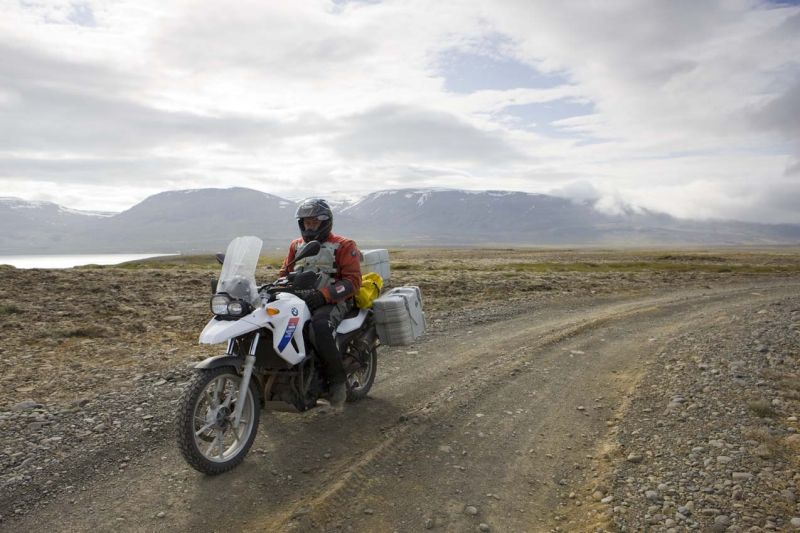
Between Vik and Höfn the road follows a relatively level course along the south coast, crossing numerous rivers via single-lane timber or metal bridges that clatter beneath the bike’s wheels. Beyond Höfn this soon changes as we enter the Eastern Fjords and Route 1 takes a more meandering course along the mountainous coast, rewarding us with stunning views and great riding. The road sweeps and climbs, long, fast straights followed by graceful sinuous bends, mountains one side, ocean the other. The bikes drift effortlessly on pristine asphalt and the distance we’re admiring one minute is upon us the next.
Djupivogur is the first town we reach, roughly 100km from Höfn, then at the northern end of Berufjörður Route 1 turns to gravel and after a few kilometres we reach a point where we can either follow the fjord and rejoin tarmac or hang a left, cut 60km off the run to Egilsstaðir but enjoy 40km or more of gravel riding. Guess which one we go for? It’s great to be kicking up dust and feeling the bike squirm on the loose surface – disconcerting at first, but fun when you get into the rhythm and open the throttle. The bends are tighter now, the climbs steeper. We pass a waterfall, then the snow line, but not cars. This is amazing!
North of Egilsstaðir the scenery becomes empty and desolate as we enter the North East. Our destination is Lake Myvatn and the temperature has dropped by several degrees – noticeable on a bike. Roughly half way, we round a bend and are faced with a breathtaking view across a landscape that’s just how I imagine the moon to look. Below us a flat, gravel plain stretches for miles to soaring mountains and Route 1 cuts straight across it like pencil line. We stop to take photographs but don’t dally for long – we want to ride through it, not look at it. You just don’t get roads like this in the UK, or such empty spaces – 170km between towns! With no hotel booked for the night we’re hoping there will be a bed in Reykjahlið, on the shore of Myvatn. Our luck’s in, though at £150 for a twin with breakfast, the wallet takes a pounding. Iceland doesn’t do budget travel unless you camp. Even a cheap hotel or guesthouse will set you back £70. Fuel’s a little less pricey than the UK at around £1.30 a litre, but at £5-6 a pint, beer ain’t. Needless to say, there’s no all-night partying for us!
All right geyser
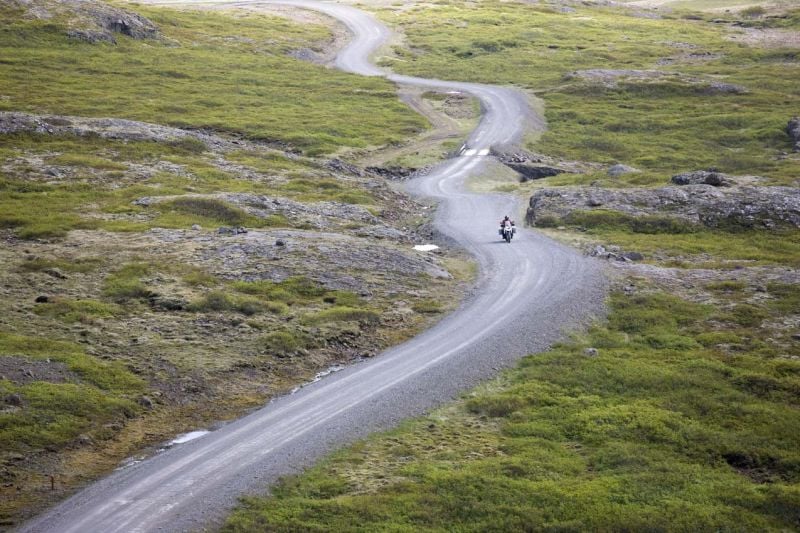
Myvatn is the gem of the north, complete with a tranquil lake, colourful mountains, volcanic craters, steaming fumeroles and bubbling mud pools. It’s Iceland as you expect it to be, though when we rise for Day four the weather’s distinctly dull so we don’t see it at its best and decide to crack on towards Akureyri, Iceland’s second city with a population of almost 17,000. En-route we stop briefly at Godafoss, or ‘God’s Falls’, another photogenic waterfall just off Route 1. The weather soon picks up and before long we riding through Alpine scenery of snow-capped mountains in sunshine beneath a fantastic blue sky.
It’s amazing how sunshine raises the spirits and with perfect tarmac beneath our wheels the miles pass effortlessly until we reach Blönduós, a town of 700 set on the banks of the River Blanda. It’s only 3pm but we’ve planned to spend the night here so we ride into town and book a room in the ‘top’ place according to my guide book. I’d hate to see the ‘bottom’ place! With time to kill and no desire to hang out in the empty hotel, we ride out of town onto the Vatnsnes Peninsula, picking up the F711, a fantastic gravel road that winds its way across a stark, rocky landscape to one of Iceland’s biggest seal colonies and eventually Hvitserkur, a weird rock formation off the coast that has been eroded into the shape of an elephant.
Annoyingly, we forgot to fuel-up before leaving Blönduós and after a couple of hours of fun on the gravel, with no fuel gauges on the bikes other than the reserve light, we turn back, worried that if we venture further we may not have enough unleaded to get back to town – and it’s a long walk!
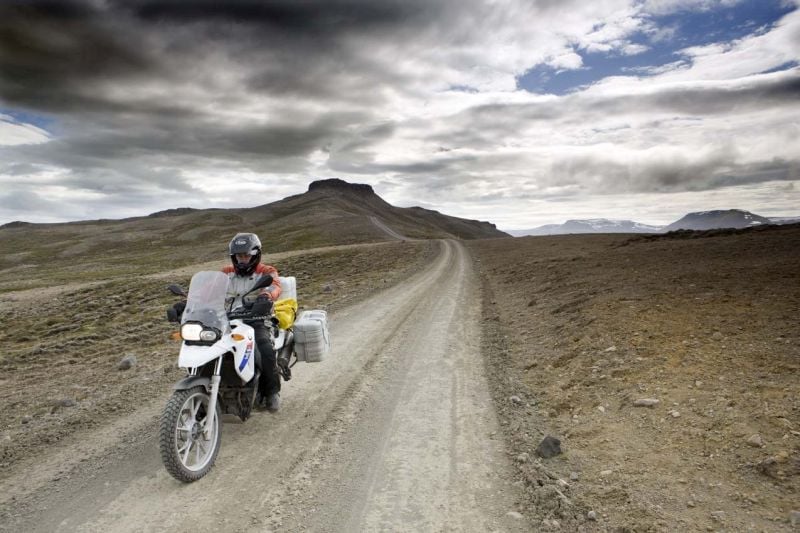
Our final full day of riding takes us from Blönduós down to ‘The Golden Circle’, a popular tourist route off the ring road that covers Þingvellir National Park, Geysir and Gullfoss, all accessible from Reykjavik. The day starts cold – just 4°C – but then we are in the North of Iceland and the Arctic Circle isn’t far away. Add the wind chill and it’s more like zero. An hour later we stop at a service station to fuel up and warm up. A bunch of leather-clad sports bikers heading to Akuryri have the same idea. One of them is English, though he’s lived on Iceland for over 20 years, and warns us of fog ahead. Fog! My dipped beam blew two days back so I ride with the high beam blazing and the visor up. Icelandic drivers are a law-abiding lot who stick to the speed limit, but it only takes one idiot to overtake when visibility’s down to 20 yards. Fortunately, we’re soon through the soup. The road drops into a valley and we leave it well behind. Borganes is the first big town we approach, but we’re also heading towards to most populated area of Iceland and it shows – more traffic, more people, more buildings. After days riding through virtual emptiness, it’s a shock and we decide to stay as far away from it as we can for as long as we can.
Instead of taking the most direct route via Akranes, we detour onto route 47 and wind around Hvalfjörður. The wind is scarily strong and we´re leaning the bikes at worrying angles just to keep them in a straight line, but the road is fantastic and the scenery magical. Road F48 gives us our final gravel fix as we cut across to tarmac on route 36 and Þingvellir.
It’s Independence Day in Iceland so Þingvellir is much busier than expected. The Vikings established the world’s first democratic parliament, the AlÞing, here in AD930 so it’s a sacred place to Icelanders and they’re out in force to celebrate. It’s also where the North American and Eurasian tectonic plates play tug-of-war and are slowly pulling the earth’s surface apart at a rate of 2mm per year.
We spend a while exploring its haunting landscape of stunted trees and deep mossy fissures before heading to Geysir. The original Great Geysir (all other geysers in the world are names after it) used to blast water 80m into the air but it’s less active today. Fortunately, Strokkur Geysir, about 50m away, blows its top every six minutes so you don’t have to wait long for a geyser fix – and a soaking if you stand downwind of it!
Final blast
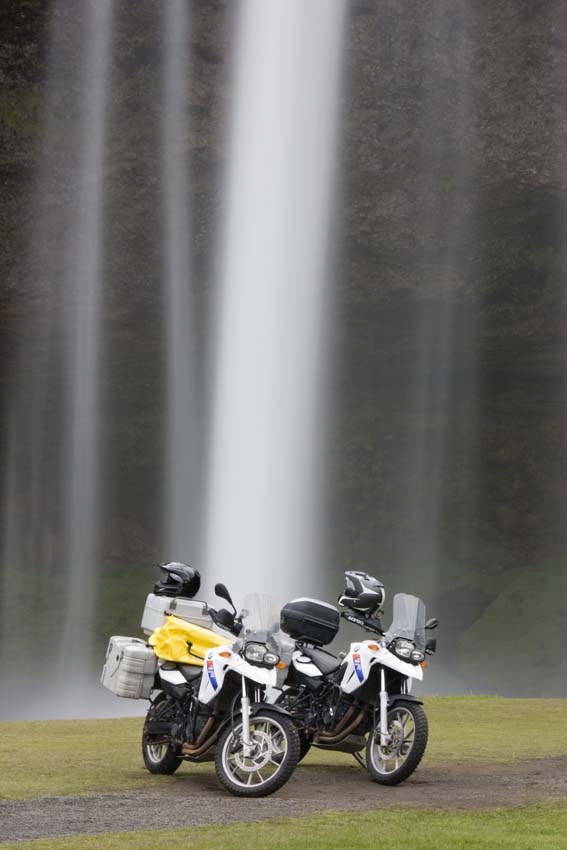
If you can cope with another waterfall, Gullfoss is 10km down the road from Geysir and worth a visit. It’s big, impressive and on a sunny day has a permanent rainbow thanks to the curtain of spray being kicked-up as the water plunges into a narrow ravine. Unfortunately, instead of sunshine we have strong winds blowing in exactly the wrong direction and so much spray is heading our way that it’s impossible to take any photographs even from a distance. A German biker on an Africa Twin who we’d bumped into earlier doesn’t even bother to take his helmet off and after several failed attempts to snap the falls we give up and head to nearby Hotel Gulfoss.
The last 100km back to Reykjavik mark the end of the trip and though we’re disappointed that it’s almost over, we get one last blast of excitin’ ridin’ on route 425. Climbing high above Nesjavellir
geothermal plant we open the throttle and make the most of the tight twists and turns. It’s wide smiles all the way back into town, following a pipeline that carries super-heated water 23km into Iceland’s capital so everyone can have a sulphur-smelling shower and keep their driveways snow-free with underground pipes. Clever stuff.
Riding Iceland’s Ring Road isn’t a great biking challenge. You’re not going to run out of fuel and stave to death, or get attacked by bears in the wilderness and you don’t even need much biking skill to complete it. But if you fancy a few days of adventure in a country that’s home to Europe’s most amazing natural wonders, Iceland is the place. From smouldering volcanoes to drifting icebergs, mammoth glaciers to thundering falls, empty desert to soaring mountains, exploding geysers to bubbling mud, it has the lot – and you’ll see it all from Route 1.
We’re already planning our return.
Who’s riding?
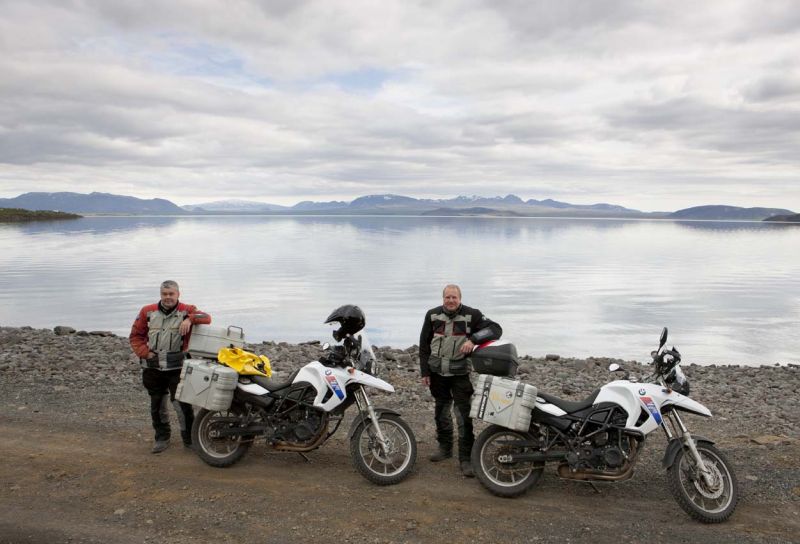
Lee Frost
A leading landscape and travel photographer, Lee’s also penned close to 20 books and hundreds of magazine articles on photography and leads photo workshops and tours all over the world (www.leefrost.co.uk). He hails from Yorkshire but has lived on the Northumberland coast for the last decade. When he’s not behind a camera or riding a bike you’ll probably find him on the beach. Sat on Ted Simon’s Triumph in Coventry Transport Museum in the mid-80s and the adventure seed was sown.
Mark Brookes
Had the misfortune of going to the same school as Lee and 30-odd years later they’re still mates. A master draughtsman by day, chances are you’ve driven past one of his monster scaffold designs somewhere in the UK. He still hails from Yorkshire and as a result is as difficult to understand speaking English as an Icelander is speaking Icelandic. Also sat on Ted Simon’s bike – though he waited until Lee got off, otherwise it would have been a bit weird.
The bikes
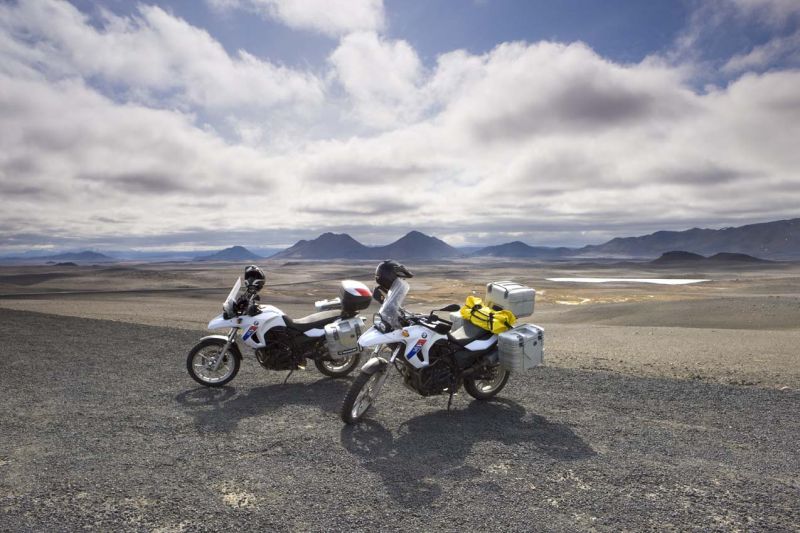
Lee and Mark hired their BMW F650 GSs from Biking Viking in Reykjavik complete with Hepco and Becker Gobi panniers, plus top boxes. Bike hire in Iceland isn’t cheap – the GSs cost £150 Euro per day for a five-day hire with insurance – but they’re well maintained and didn’t miss a beat. If you want to bring your own bike you have two options – either ride it to Denmark then take a three-day ferry ride to Iceland or crate it and ship it over from Grimsby. For long trips this is worth the hassle and expense, but for a short trip, flying and hiring is much more convenient.
Don’t worry about suitcases and other stuff you won’t need on the ride – just leave it at the Biking Viking HQ.
Biking Viking is the only bike hire outlet on Iceland and has just added 10 new Triumph Tiger 800s to its fleet. Guided bike tours are also available. Go to www.bikingviking.is for more info.
Learn to speak Icelandic
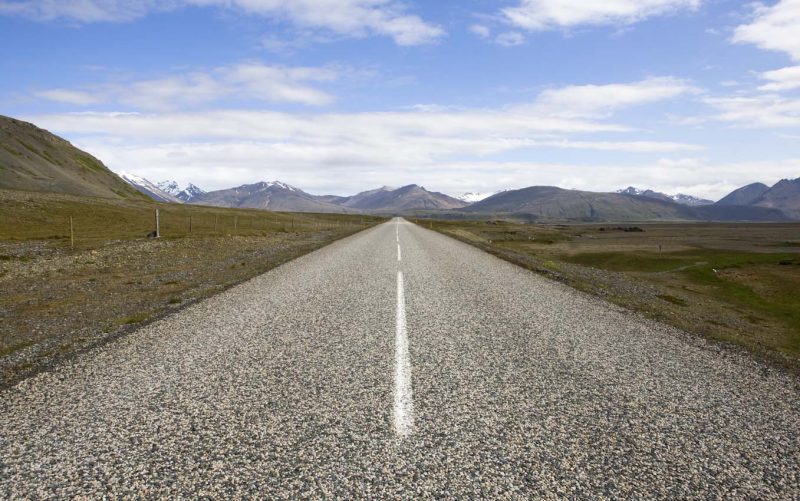
The Icelandic language is as close to Old Norse as you’re going to get, so close that Icelandic speakers can read ancient Viking texts. It’s a difficult language to pick up, but the majority of Icelanders speak perfect English so communication isn’t a problem. That said, it’s still worth knowing how to pronounce place names. The main things to remember are:
ll is pronounced ‘ddl’ as in ‘fiddle’
Þ is pronounced ‘th’ as in ‘thing’
j is pronounced ‘y’ as in ‘yes’
ö is ‘er’ as in ‘fern’ but with a silent ‘r’
So…
Seljalandsfoss is Selyalandsfoss
Jökulsarlón is Yerkulsarlon
Þingvellir is Thingvettlir
Nesjavellir is Nesyavettlir
Eyjafjallajökull is Ay-uh-fyat-luh-yoe-kuutl
See, easy! Now it’s your turn.
Need to know Iceland
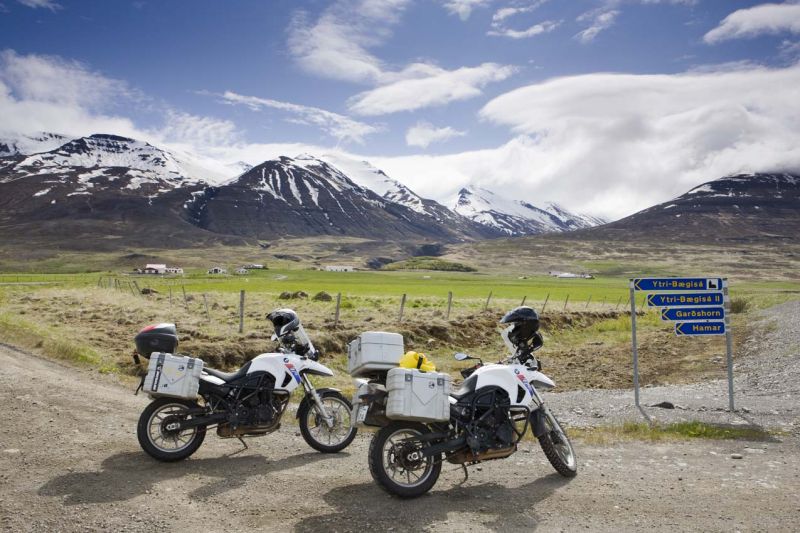
• Despite the name, Iceland isn’t as cold as most folk assume. Being so close to the Arctic it’s not the warmest of countries, but the climate is kept mild by the North Atlantic Current, snow at sea level is rare in places and the average winter temperature is higher than in New York. Iceland in Icelandic also means ‘island’. Nowt to do with ice!
• Iceland covers an area of 103,000 sq km and has a population of approx 320,000, so the population density is around 3 people per sq km – though 60% of the population live in or near Reykjavik. That means lots of open space and not many people. Perfect for bikes.
• Icelandic people don’t use family names. Instead, the father’s (and occasionally the mother’s) christian name is used. So, if Magnus Johansson has a son names Eypor, instead of being Eypor Johansson he will be Eypor Magnusson – Eypor, son of Magnus’. If Magnus Johannson has a daughter named Katrin, she will be Katrin Magnusdottir – Katrin, daughter of Magnus. Geddit?

